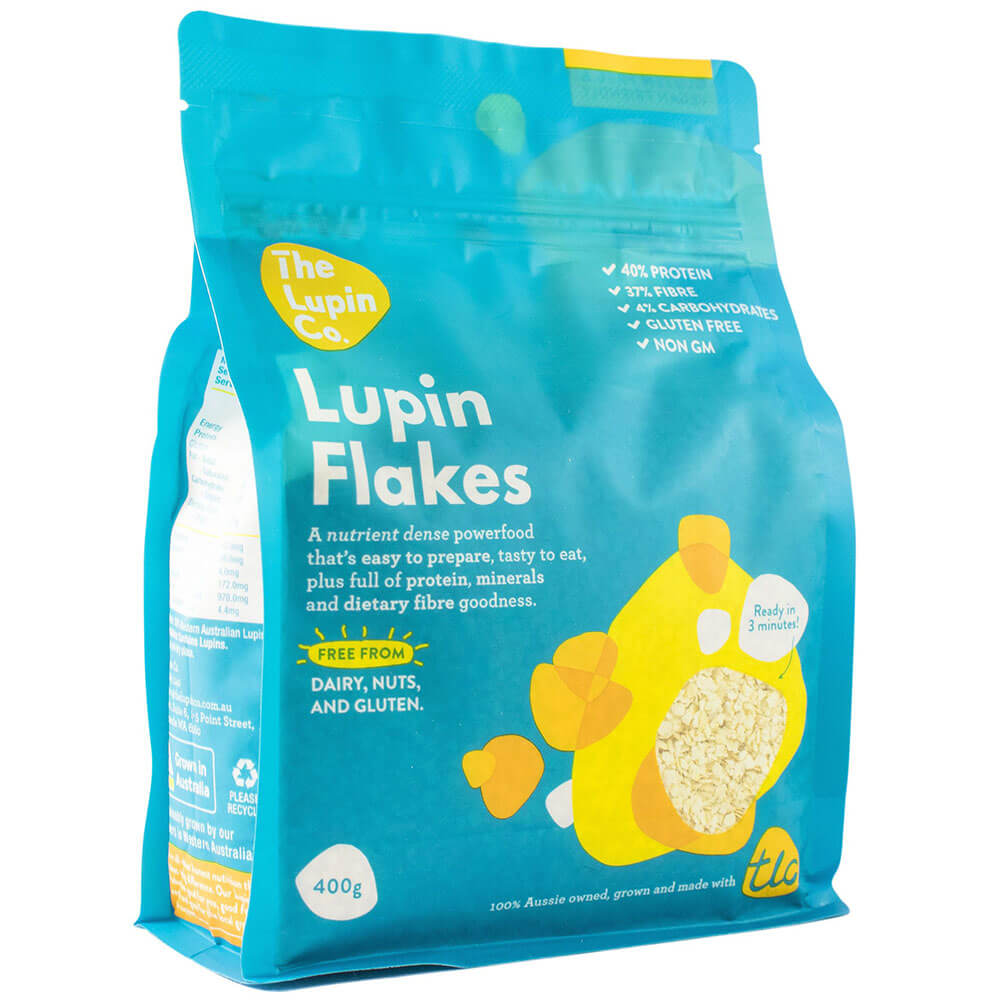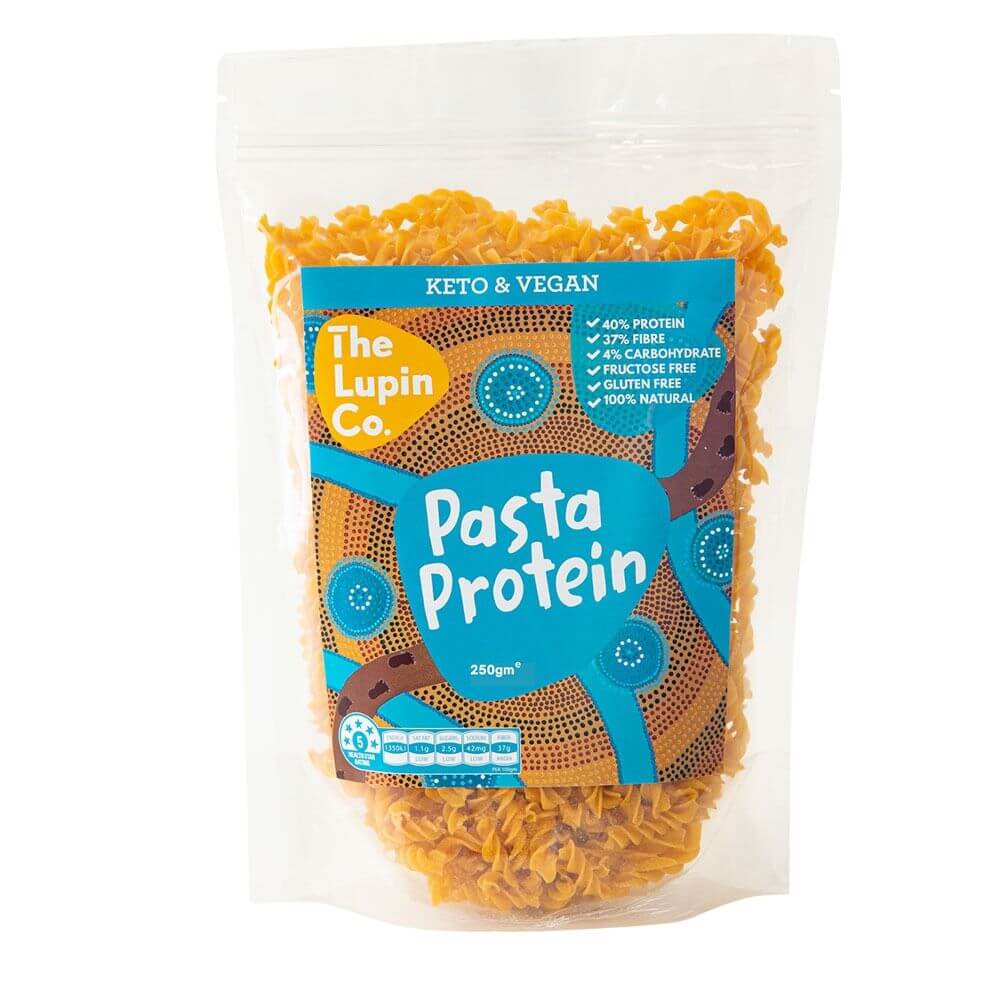What Is Lupin ?
Many people ask,
“What exactly is lupin?”
We’re here to clear up the confusion and answer all your questions.
The Lupin Co. offers many versatile, nutrient-rich products derived from Australian Sweet Lupin beans. All are excellent additions to various diets, including gluten-free, keto, vegan, and plant-based lifestyles.
-
High in Protein and Fiber: Supporting muscle health and digestion.
-
Low in Carbohydrates: Suitable for low-carb and keto diets.
-
Gluten-Free and Vegan: Ideal for those with dietary restrictions.
-
Rich in Essential Minerals: Beneficial for overall health
Incorporating lupin products into your diet can enhance nutritional intake while offering culinary flexibility.
Made by grinding dehulled Australian Sweet Lupin beans into a fine powder. It’s naturally gluten-free, vegan, and non-GMO, containing only one ingredient: lupin beans. This flour is notable for its high protein content (approximately 40g per 100g) and substantial dietary fiber (around 38g per 100g), while being low in net carbohydrates (about 4g per 100g).
Nutritional Highlights (per 100g): All products
- Protein: 40g
- Dietary Fiber: 38g
- Net Carbohydrates: 4g
- Fat: 6g
- Minerals: Rich in potassium, calcium, magnesium, and iron
Lupin Flour
The Lupin Co – High-Protein Lupin Flour
Upgrade your kitchen with the ultimate high-protein flour! Packed with an impressive 40g of protein per 100g, our lupin flour is a game-changer for baking and cooking. Swap out up to 20% of regular flour to boost protein and cut carbs—without compromising on taste!
Why Choose High-Protein Lupin Flour?
Nutrient-Rich – Over 40% protein and less than 4% digestible carbs
Diet-Friendly – Perfect for coeliac, keto, and vegan diets; eco-friendly too!
Versatile & Delicious – Great for baking, smoothies, dips, pancakes, and more
Culinary Uses:
Lupin flour’s mild, slightly nutty flavour makes it suitable for various recipes. It can be used to make keto-friendly bread, pasta, biscuits, pizza crusts, muffins, tortillas, and more. You can even mix it into juices and smoothies.
Lupin Flakes
Elevate Your Meals with The Lupin Co’s High-Protein Lupin Flakes!
Packed with flavour and nutrition, these powerful flakes are a pantry essential, offering a perfect balance of protein and fibre to fuel your day.
Why You’ll Love Lupin Flakes:
Nutrient-Rich – Loaded with calcium, potassium, magnesium, and iron
Protein & Fibre Powerhouse – Supports a balanced, healthy diet
Low-Carb & Low GI – Just 4% carbs for sustained energy
Gluten-Free & Coeliac-Friendly – A great alternative for gluten-sensitive diets
Culinary Uses:
Lupin flakes are incredibly versatile. They can be enjoyed raw or incorporated into various dishes:
- Breakfast: Sprinkle over yogurt or blend into smoothies.
- Baking: Add to bread, muffins, or pancakes for extra nutrition.
- Cooking: Use in casseroles, stews, or as a crumb coating for proteins.
- Snacking: Toast and season for a crunchy snack.
Lupin Pasta
High-Protein, Low-Carb Protein Pasta Spirals
Elevate your meals with our high-protein, low-carb pasta, made from 100% natural ingredients and packed with fibre. With just 4% carbs and a robust protein profile, these spirals are the perfect addition to a healthy, balanced diet.
Why You’ll Love It:
Low-Carb & High-Protein – Perfect for keto, low-carb, and high-protein diets
Quick & Convenient – Cooks in under 3 minutes—no boiling needed!
All-Natural – Made with clean, wholesome ingredients for a guilt-free meal
Culinary Uses:
Pasta (of course), Bakes. Salads, Soups, Stews
Whether you’re preparing a hearty pasta dish or a refreshing salad, The Lupin Co’s Protein Pasta Spirals are the ideal way to enjoy a nutritious, satisfying meal in no time!
Lupin Splits/Dahl
These may resemble split peas, but they pack a powerful punch — with 40% protein, just 4% carbs, and twice the protein of regular split peas. Naturally gluten-free, non-GMO, low GI, and keto-friendly, they’re also rich in fibre and essential minerals like calcium, potassium, magnesium, and iron. Ideal for soups, stews, casseroles, or even fermenting into tempeh — they’re simply
Culinary Uses:
Lupin Split/Dahl are incredibly versatile. They can be enjoyed raw or incorporated into various dishes:
Cooking: Use in Casseroles, Soups & Stews, Dahl, Curries & Fritters
Do I need to Soak Lupin Splits?
No, you generally don’t need to soak lupin splits before cooking. The sweet variety is already prepared and can be eaten raw or cooked without prior soaking.
If you follow a low-carb diet, you’re likely familiar with almond and coconut flours — but have you come across Australian Sweet Lupin (ASL) flour, also known as Lupinus Angustifolius? Not only does this legume plant produce beautiful white flowers, but it’s also the source of a powerhouse flour that’s gaining traction among vegans, coeliacs, and keto enthusiasts.
ASL flour is made from the lupin bean — a high-protein, high-fibre, low-carb legume that’s distantly related to soybeans and peanuts. While traditional Lupinus Albus (bitter lupin) beans have long been eaten pickled in Mediterranean countries, their natural bitterness and high alkaloid content (similar to compounds like caffeine and quinine) made them less appealing for everyday use.
Thanks to modern cultivation, we now have a sweeter, non-bitter variety — Australian Sweet Lupin. The yellow centre of these beans is milled into a light, versatile flour perfect for low-carb baking and a wide range of recipes.
What Is Lupin Flour and Is It a Keto Flour?
With just 1g of net carbs and a generous 11g of dietary fibre per ¼ cup, lupin flour is a perfect match for ketogenic and low-carb lifestyles. It’s not only low in carbohydrates but also gluten-free, non-GMO, and virtually starch-free — making it ideal for those watching their blood sugar, as it ranks low on the glycaemic index.
Australian Sweet Lupin flour is also packed with energy-boosting protein and beneficial bioactive compounds like carotenoids, antioxidants, and phytoestrogens. Its mild, versatile flavour makes it easy to incorporate into everyday cooking — think keto bread, pasta, biscuits, pizza bases, muffins, tortillas, and more. You can even blend it into smoothies or stir it into juices for a nutritious boost.
Ingredients and Nutritional Value of Lupin
Australian Sweet Lupin flour is as pure and simple as it gets — made from just one ingredient: Australian Sweet Lupin beans. This dry-processed plant protein is naturally vegan, gluten-free, and non-GMO, making it suitable for a wide range of dietary needs.
Nutritionally, lupin flour is a true powerhouse. Just ¼ cup provides:
- 75 calories
- 2g fat
- 1g net carbs
- 11g dietary fibre
- 12g plant-based protein
It’s also rich in essential vitamins and minerals, supporting overall wellness. With its impressive profile, lupin can aid in weight management, support digestive health, and contribute to balanced energy levels.
- Excellent Source of Complete Protein
- High in Dietary Fibre
- Nutrient-Dense
What Does Lupin Taste Like?
Australian Sweet Lupin has a mild, neutral flavour with a subtle, slightly starchy note. Its texture closely resembles wheat flour, making it an excellent substitute for baking. Unlike many keto-friendly flours, it’s light, fluffy, and less dense — perfect for achieving a soft, airy crumb.
Unlike the bitter varieties of lupin found elsewhere, Australian Sweet Lupin flour has no bitter aftertaste. It blends seamlessly with other flours like wheat, almond, or coconut, making it incredibly versatile in both sweet and savoury recipes.
Are There Any Side Effects of Consuming Lupin Flour?
Australian Sweet Lupin is a legume, closely related to peanuts and soybeans. While lupin is safe for the vast majority of people, those with existing peanut or soy allergies should exercise caution. Less than 5% of individuals with a known peanut allergy have shown any clinical reaction to lupin, but it’s still wise to consult your healthcare professional if you have concerns.
If you’re interested in incorporating lupin into your cooking, our friendly team at The Lupin Co. is here to help. We’re a 100% Australian-owned and operated company committed to improving health and wellbeing through premium-quality Australian Sweet Lupin products.
We are proudly BRCGS-certified and hold all key quality and cultural certifications, making it simple to include our lupin products in your home or business. In addition to our signature Australian Sweet Lupin Protein Flour, we also offer:
- Lupin Protein Flakes
- Lupin Protein Pasta
- Lupin Superfoods – ready-to-bake range
- Lupin Dahl/Splits
- Lupin Cereal
Looking for recipe inspiration or need help sourcing lupin flour near you? We’re more than happy to share ideas, provide guidance, and direct you to local distributors. You can also order directly from our website or get in touch with us:
📞 +61 8 6263 1140
📧 enquiries@thelupinco.com.au
💬 Or connect with us on social media — we’d love to hear from you!





